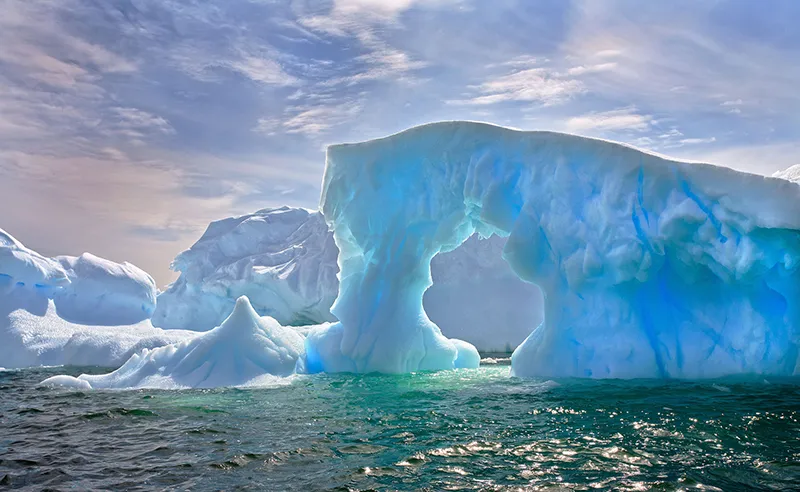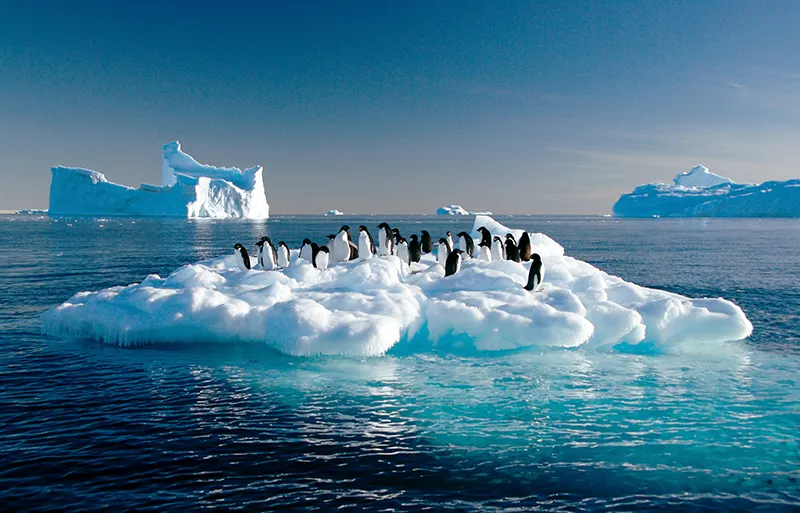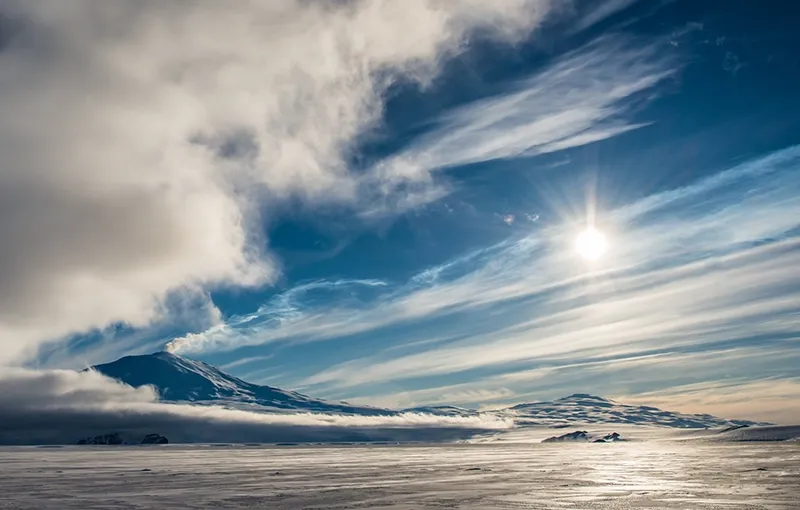The harsh, ice-clogged Weddell Sea appears in the stories of sailors and even the staff of Antarctic research stations as a water area of mysteries, sometimes of the most mystical nature.
The entire planet depends on climatic conditions in Antarctica, and the Weddell Sea in particular. As the ice shelves are melting intensively, the water level in the world’s oceans is gradually rising.
Southern Ocean Sea
The Weddell Sea is the southernmost sea on Earth. It is covered by floating ice floes and icebergs that have broken away from ice shelves almost all year round.
The Weddell Sea is considered one of the oldest and one of the least studied seas of the World Ocean.
The discoverer of the Weddell Sea, the Scottish navigator and whaler James Weddell (1787-1834) came here in 1823 by two ships, the Boothey and Jane, in search of seal rookeries (although some researchers dispute this fact). The sea was named after King George IV of England at the time (1762-1830), but the name did not stick. For the second time people saw the sea only in 1911, during an expedition of the German traveler and writer Wilhelm Filchner (1877-1957). Today the sea bears the name of its discoverer.
The south coast of the sea throughout its length is a succession of shelf glaciers, among which the largest are the Ronne and Filchner glaciers with a total area of 422,420 km2 (until the late 1960s they were considered a single formation). The Ronne Shelf Glacier is located between Palmer Land and Elsworth Land to the west and the Berkner Upland and Pensacola Mountains to the east. It was first explored in 1947 by an expedition led by American-born Norwegian Finn Ronne (1899-1980). It was originally named Lassiter Glacier, but was later renamed to Ronne Glacier, in honor of Edith, the wife of Finn Ronne, who accompanied her husband on the expedition.
The Filchner Ice Shelf Glacier, with an ice thickness of up to 700 m, stretches between the Luitpold Coast and the Berkner Upland. It was discovered in 1912 by Wilhelm Filchner’s Antarctic expedition on the Deutschland ship and was named after him.
Approximately every 10-20 years, giant icebergs break away from the glaciers and drift northward across the Atlantic Ocean. In 1998, an iceberg with an area of 7,500 sq. km. was calved from the Ronne and Filchner glaciers and was designated A-38. In 2000. The iceberg A-43 with an area of 5344 km2 “set sail”. Later these giant icebergs split into many smaller ones, which drift across the entire World Ocean, covering a distance of up to 13,500 km.
If you calculate the area of the Weddell Sea together with the ice shelves, it exceeds 3 million km2.
In winter the water temperature in the southern part of the sea drops to -1.8 ° C and the water becomes very dense. Water in the Weddell Sea has the highest density and salinity in the Antarctic region (in general, due to the desalinating effect of melting glaciers, Antarctic waters remain low-salinity). The reason is that when ice forms, the salinity of the remaining water increases, as well as its density.
In the Weddell Sea, a circular current of the same name, one of two near the coast of Antarctica, moves in the water column. The Weddell Current rotates clockwise and is formed under the influence of the Antarctic Westwind Current.
As a result of upwelling (upwelling of deep water to the sea surface), cold masses of water bring plankton to the surface, which feeds on fish and cetaceans that inhabit the Weddell Sea in abundance.
The Weddell Sea is one of the cleanest, coldest and clearest in the world’s oceans. In 1986, a German expedition on the research vessel Polar Star recorded almost perfect water transparency here: 79 м.
The Weddell Sea is located off the coast of West Antarctica, between the Antarctic Peninsula in the west and the Cotes Land in the east. During most of the year, the sea is covered with drifting ice floes, whose thickness exceeds 2 meters, as well as countless icebergs. The Weddell Sea is nicknamed the “Ice Bag” because of the compression of the ice.
The seas, their characters, and their inhabitants are often legendary. The Weddell Sea is no exception: there are enough fascinating stories about it to make a book. The legend of the green-haired “waterman” of the Weddell Sea – a male mermaid, in which superstitious sailors have believed for the last hundred years – is a tall tale. In all likelihood, whales and seals, the main fauna of the Weddell Sea, are thought to be “watermen. The most widespread species is the Weddell seal, discovered here by the same James Weddell in the 1820’s. This amazing creature is 3.5 meters long on average. The Weddell seal sometimes spends about an hour underwater, not rising to the surface and descending to a depth of 800 m.
At the end of the Triassic period, the supercontinent Gondwana began to disintegrate; the process of splitting began at the southern tip of what is now South America, South Africa and West Antarctica, which in those distant times was a single whole. The reservoir formed there was the beginning of the future Weddell Sea, then still cut off from the waters of the World Ocean, and the same area subsequently became the Southern Ocean around Antarctica. The sea, then closed for another 40 million years, is now considered the cradle of life for many later common marine species.
Among the sea’s unusual inhabitants are the glassy carnivorous sponge, the pink polychaete polychaete worm, translucent isopods, foraminifera and blind snails.
The Weddell Sea gained fame as the “cursed” place in Antarctica. Rare ships that ventured into the Weddell Sea, until 1949, 120 years after its discovery, could not approach its shore, because they simply could not find it among the endless glaciers.
There is also a known phenomenon called “flash freeze,” when the water in the sea freezes literally before your eyes, restraining the ship and forcing the crew to abandon it. This is what happened, for example, in 1915 to the British research vessel Endurance.
The shipping conditions in the Weddell Sea are extremely unfavorable: in addition to ice compression and the unpredictable appearance of icebergs there is also a treacherous circular current. That is why fishing seiners prefer not to call here. Only research ships and tourist icebreakers dare to conquer these dangerous waters.
In the XX century on the Filchner glacier worked Antarctic stations of the USSR (“Druzhnaya”), the USA, Great Britain and Argentina. All of them were abandoned and frozen into the ice strata. Nevertheless quite a few stations continue their work for more than fifty years, new ones are being opened, now the stations “Belgrano II” (Argentina), “Vasa” (Sweden) and “Aboa” (Finland), “Halley” (Great Britain) and others work on the shores of the Weddell Sea, so we can say that the population on the shores of the Weddell Sea numbers several hundred people.
For the Argentines, the station is also important because it is a symbol of the country’s territorial claims to the Antarctic sector of the Weddell Sea. The Argentines justify their claim, in particular, by the fact that their country was the first to develop Antarctica, installed lighthouses, and built the first airfield on the continent in 1969.
The area of the Weddell Sea is also claimed by Britain (because of the relative proximity of the Falkland Islands) and, in part, by Chile. All this generates discrepancies in geographic names: the same islands are named differently on different maps. However, no country has yet dared to take decisive action to invade this sector of Antarctica.
General Information
- Location: Atlantic sector of the Southern Ocean, east of the Antarctic Peninsula, 40th degree west longitude, passing roughly mid-sea divides its coast between East and West Antarctica.
- Year of discovery: 1823.
- Territorial claims: Great Britain, Argentina, Chile.
- Neighboring seas: Scotia Sea.
- The largest islands: Berkner (the southernmost island on Earth and second largest in Antarctica), James Ross, Hurst.
- Largest ice shelves: Ronne, Filchner.
- Active polar stations: Halley (Great Britain), Belgrano II (Argentina).
- Area: about 2,920,000 km2.
- Maximum width: about 2,000 km.
- Average depth: 3,000 m.
- Maximum depth: 6820 m.
- Volume: 329,700 km3.
- Salinity: 33.5 per cent.
- Average ice thickness: more than 2 m.
- Area of the largest ice shelves: Ronne, Filchner (total area – 422 420 km2).
Climate and weather
- Antarctic.
- In the northern part of the sea, the climate is subantarctic.
- Average water surface temperature in January: -1.5°C.
- Average water surface temperature in July: -1.9°C.
- Average annual precipitation: About 600 mm.
- Relative humidity: 85%.
Economy
- Minerals: traces of natural gas have been found offshore.
- Light bitumens are found on the coast.
- Services: cruises on Antarctic liners.
Attractions
- Natural: Antarctic Sound Bay with its table icebergs, the Ronne and Filchner ice shelves, the waterfall on Vega Island in the Well-Met tract, penguin colonies (Pole Island), peaks on Devil and Beek islands.
- Others: the Belgrano II Antarctic Station (Argentina), fossil remains on Seymour Island, and the historic cabin of the Nordenskiöld expedition (Snow Hill Island).
Fun Facts
- Many mature individuals of the Weddell seal have broken fangs. In the fall, the seals gnaw holes in the new ice through which they breathe. Subsequently, they gnaw away at the ice as it freezes.
- Scientists managed to make a serious contribution to the study of the Weddell Sea in 1957-1958, during the Third International Polar Year. In preparing this IPY, very few surviving materials from the previous IPY were used: almost all of them were lost during World War II.
- During a voyage off the coast of Antarctica in 1823, James Waddell reached 74°S latitude. After him it was done only in 1904 by the expedition of the Scottish Antarctic explorer William Spears Bruce (1876-1921).
- The Finn Ronne Antarctic Expedition of 1946-1948, which explored the Weddell Sea shoreline, saw its members cross 3,600 miles on skis and dogsleds: more than any other Antarctic expedition in history. Edith Ronne, wife of Finn Ronne, accompanied him on the expedition as a chronicler and correspondent for American newspapers. She and the chief pilot’s wife, Jenny Darlington, were the first women to survive wintering in the ice of Antarctica.




